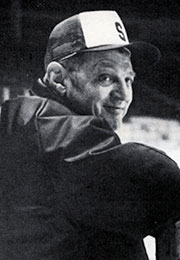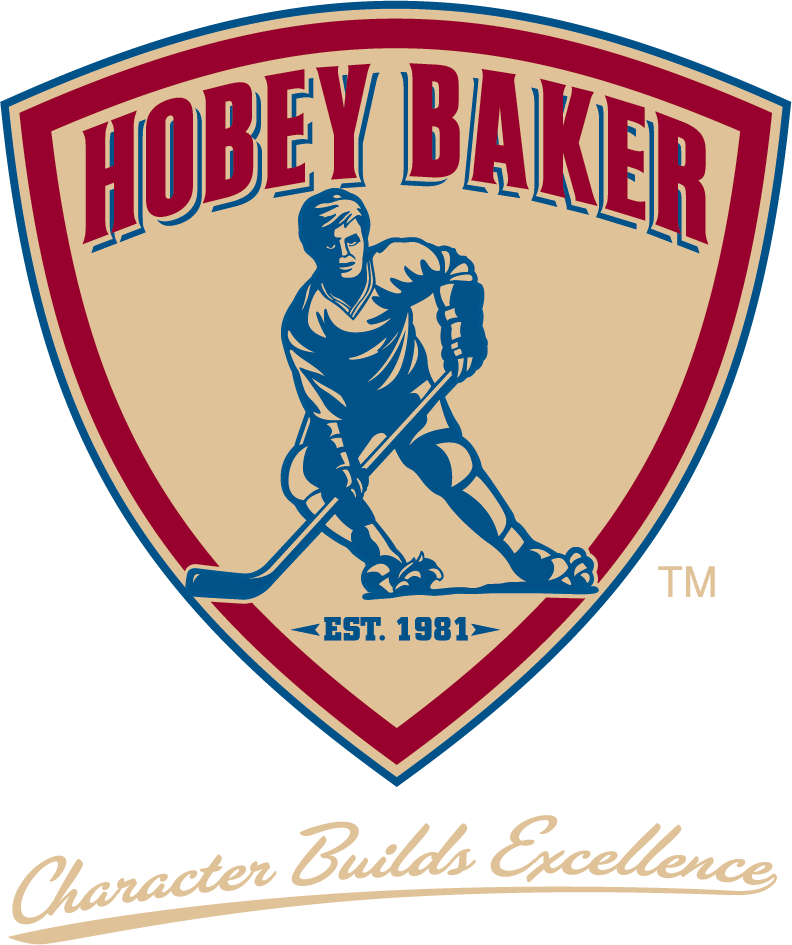Amo Bessone – 1986 Legend of College Hockey

Thirty-five years ago, college hockey wasn’t where it’s at today. Many schools didn’t have indoor stadiums, many of the leagues weren’t yet formed, and the fans were few and far between.
Over the years college hockey has grown to what we know it as today, but it wouldn’t have been possible without the hard work and dedication of many people.
One such person is our honored guest, Amo Bessone. In his 31 years coaching college hockey, 28 of them at Michigan State, Bessone gained great respect in the hockey world.
“Amo was one of the most respected and revered individuals in hockey,” said John Mariucci, one of the great pioneers of United States hockey, and an old friend of Bessone. “He made so many contributions to the game of hockey.”
Bessone started playing hockey when he was nine years old in his hometown of West Springfield, Mass. “We lived right across the street from the rink,” said Bessone. “But we also did a lot of our skating out on the lakes or ponds.”
Besides hockey, Bessone also played football and baseball. “It kept us off the streets,” he said. Hockey was his favorite sport, and Bessone credits his older brother Peter with helping him along. “I remember when we’d be the only two out on the ice before school,” said Bessone. “I always looked up to my brother Peter, he helped me a lot.”
When Bessone was sixteen he played hockey in Paris, France for one year. “That was during the depression days, jobs were hard to find, it didn’t cost me to live, and it gave me great experience,” he said.
After graduating from high school, Bessone attended the University of Illinois, where he played four years of hockey under coach Vie Heyliger, and two years of baseball. Bessone earned letters in both sports, and was captain of the hockey team for two years. “Those years at Illinois were very enjoyable. I gained a lot of experience under Coach Heyliger, and I got a chance to play against such people as John Mariucci,” said Bessone.
Bessone explained that back then, college hockey didn’t have the NCAA, or the All-American teams, therefore official championship teams weren’t named, but he remembers that their team at Illinois was very strong. “We were ‘mythical champions,’ ” he said. “In my sophomore year we only lost two games, and during my senior year the team continued to win even though only seven players remained because of the war.”
After graduating from col¬lege, Bessone played professional hockey with the Providence Reds of the American Hockey League. In 1942, after one and a half years, he left this behind and enlisted in the U.S. Naval Reserves. He was as¬signed as executive officer on P.T. for active duty at Normandy Beach, and assigned to P.T. captain in the Philippine Island Campaign.
When he returned home, Bessone played for the New York Rovers, but, because he lost two years of hockey while in the navy, after one year with the Rovers he decided to try coaching instead.
Bessone’s first coaching job was at Westfield Massachusetts High School, where he was hockey coach, assistant football coach, and assistant baseball coach. He liked coaching and decided to stick with it. “I enjoyed working with the kids,” he said.
After two years at Westfield High School, Vie Heyliger, his old college coach, told him of a coaching position that was open at Michigan Tech in Houghton, Michigan. Bessone coached at Michigan Tech for three years, after which he accepted the head coaching position at Michigan State, where he remained for 28 years.
“I was very happy to get the job at Michigan State,” he said. “Michigan State had an indoor ice rink (unlike Michigan Tech) and it was a Big Ten School.”
In 1950, when Bessone became hockey coach at Michigan State, the hockey program was very new, as it had received varsity status only two years earlier. “Amo took the hockey program from its infancy,” said Mike Pearson, Assistant Sports Information Director at Michigan State. “He was instrumental in building the school’s hockey program.”
Under his direction Michigan State played in three NCAA championships; in 1959,1966 and 1967. They won the 1966 championships and Bessone was named coach of the year. “He was a very personable man, and very close to his players. He had a great ability to communicate with college-age kids,” said Pearson.
According to Pearson, it was also because of Bessone that a new hockey arena at Michigan State was built, the Clarence L. Munn Arena, in 1974. Bessone had built up the hockey pro¬gram at Michigan State so much that the old stadium, Demonstration Hall, was inadequate.
One of Bessone’s most mem¬orable years at Michigan State was in 1976. “1975-76 was one of our best teams. I remember one exciting game against Minnesota, Herb Brooks was coaching then. The game went into triple overtime and Minnesota won, then later went on to win the NCAA. After that year Brooks went on to coach the Olympic team. I always tell Herbie that I started him on to fame,” said Bessone.
In 1980 Bessone retired from coaching. “I felt it was time for a change,” he said. “It was time to move on and let someone younger take over.”
After his retirement from coaching, Bessone stayed at Michigan State for two years as rink manager. “You know, I liked that too,” he said. “It al¬lowed me to remain close to hockey, and get away from it gradually.”
When he left Michigan State, Bessone left behind a solid hockey program which he helped build.
“I attended the banquet for Amo when he was retiring,” said Mariucci. “All the coaches came with tears in their eyes. They were sorry to see him re¬tire because they were always able to beat him.” Of course Mariucci was only teasing his old friend. “He was greatly admired, and had friends all over,” Mariucci said seriously. . “His contributions to collegiate hockey are just unlimited.”
Bessone’s contributions to hockey go beyond his coaching. He was a member of the NCAA Hockey Rules Committee for 12 years, and chairman of the committee for one year. He was also president of the American Hockey Coaches Association for two years, and was instrumen¬tal in starting, and promoting, the WCHA. Bessone also conducted the Michigan State sum¬mer hockey school for ten years, and the Jackson, Michi¬gan summer hockey school for four years.
“He was a great asset to collegiate hockey,” said Mariucci.
Thinking back to his years in hockey, Bessone said that he would do it all over again. “I enjoyed it very much … at times it was a struggle. In my first 16 years at Michigan State there were maybe 12 people in the stands watching us, but in my last five, the games were sold out all the time.”
College hockey has indeed come a long way.
“It’s been very exciting to see hockey grow, knowing that I might have had a little part to do with it,” said Bessone. He humbly added that the players did most of the work.
The record shows that be¬cause of his dedication, and his love for the game of hockey, Amo Bessone made a great contribution.
“It was individuals like Amo that helped the game come along,” said Mariucci.
